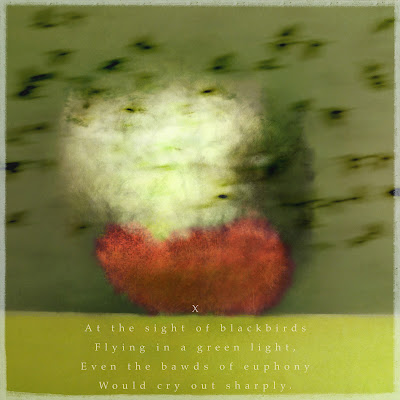Thoughts (and images) on ‘13 Ways of Looking at a Blackbird’ by Wallace Stevens:
This is a first person poem about a poet's observation and contemplations viewing a blackbird.
Each stanza is an explanation of a new way in which this blackbird has been perceived.
First, he writes about his physical perception of the blackbird as an observer. Then, he writes about his mental processes during this time.
The poem seems to be inspired by the Haiku, a very short Japanese poetic form.
Each stanza is like a polaroid snapshot.
Sight is the dominant perceptual modality. The poems are almost cinematic.
You're not supposed to understand the poem, you're invited to feel it (sensations).
The poem moves from nature to human society and back to nature in a circle.
I
The first stanza could be read as an introduction to the entire poem and a preparatory exercise for the intellect. It is also a transition from the observer's perception to the blackbird's perception. An image of one lone blackbird among twenty snow capped mountains is conjured, the only moving thing in this majestic landscape still life is the eye of the bird. In the first stanza all is about perception and perspective. In a tranquil unmoving landscape the eye of a blackbird is the only moving thing and brings momentum into the image. First the landscape is in the mind of the beholder, then perspective shifts to the view of the blackbird. The blackbird seems to stand for the Idea or thought. The snow on the mountains is motionless, not falling.
II
The second stanza is a simile of the working, conflicted mind, of different views, the self as of three minds, the tree is the mind in which 3 ideas or perspectives sit. This is the first time the connection is made between seeing the blackbird and being metaphorically the blackbird, being oneself plus the idea of a blackbird equals the new I: oneself/blackbird. Philosophically, it could be said that by seeing or thinking about another being through its eyes one could know it, know its perception of reality. This leads into the second matter that the poem addresses: The poet says that he knows himself as being a poet and that it is a part of himself as a person. However, since he also knows the blackbird, that perception makes the blackbird a part of him as well. This connection is what goes into the conclusion “a man and a woman and a blackbird are one."
III
The third stanza whirls the blackbird (the idea) about, brings chaos, movement, changes and phantasy. The season changes from winter to autumn. A pantomime is a performance told through bodily and facial movements, so each movement and gesture is communication. If the bird is a part of the pantomime, it suggests that the blackbird, the idea, is also a part of life's performance.
IV
The fourth stanza makes the Zen Buddhist point that “all things are one thing“. At this time, the connection is made that in seeing and knowing the blackbird it becomes a part of oneself.
V
The fifth stanza discusses the differences between statement (inflections) and implication (innuendoes), before whistling or after.
VI
The sixth stanza is a still portrait in vivid emotional movement and the poet observer as he watches the blackbird fly by his icy window which again brings movement into the picture.
VII
The seventh stanza might be a suggestion to the male part of our species who are thin (maybe of shallow mind), do not trust and build too much upon flittery ideas of farflung, unrealistic golden birds and rather do as the women, who have realism and realistic ordinary blackbirds at their feet to ground them in reality. Haddam is a suburban town in Connecticut close to Hartford where Stevens lived.
VIII
The eighth stanza might be a reference to the poet himself (I know noble accents and lucid, inescapable rhythms = I know how to produce nice poems) and that he knows that himself and the idea are inseparable (are one). At this time, he makes the connection that in seeing and knowing the blackbird it becomes a part of himself.
IX
In the ninth stanza, the universe is depicted as a series of concentric circles extending outward to infinity. The eye is the first circle; the horizon which it forms is the second and so on. The circle is that through which we see and the limit of what we see. So if the blackbird marks the edge of many circles it flies to the limit of one’s knowledge.
X
The tenth stanza calls poets bawds of euphony, manufacturers of well-sounding, who would cry out at the sight of blackbirds in green light. Why do they cry out? Out of horror or joy?
XI
The eleventh stanza shows the poet, who is protected but not hidden from the outside by a glass coach, and his fear (of reality?) caused by the shadow of his carriage (maybe an airplane) which he sees as shadows of blackbirds.
XII
The twelfth stanza is a reference to the stream of life which is moving and therefore, as not to get lost, to adapt, the blackbird must be flying / changing. A cause/effect relationship emerges from the words "must be." The blackbird is reality; if it is flying it is changing, expanding in the perception of the beholder.
XIII
The thirteenth stanza is bringing the blackbird at last to a stillpoint, the atmosphere is one of tranquility, rest, of an outlook towards death, an old person in his everlasting afternoon/ evening of life. The snow is falling and shall keep falling - back to stanza one, to the snow covered mountains.
There is no one way of looking at the world, but many ways, none of them superior, all of them choices or decisions.
#robertfaeth, #painterinBerlin, #painting, #art, #bookblog, #bookreviews, #literaturelover, #poem, #poetry


















No comments:
Post a Comment